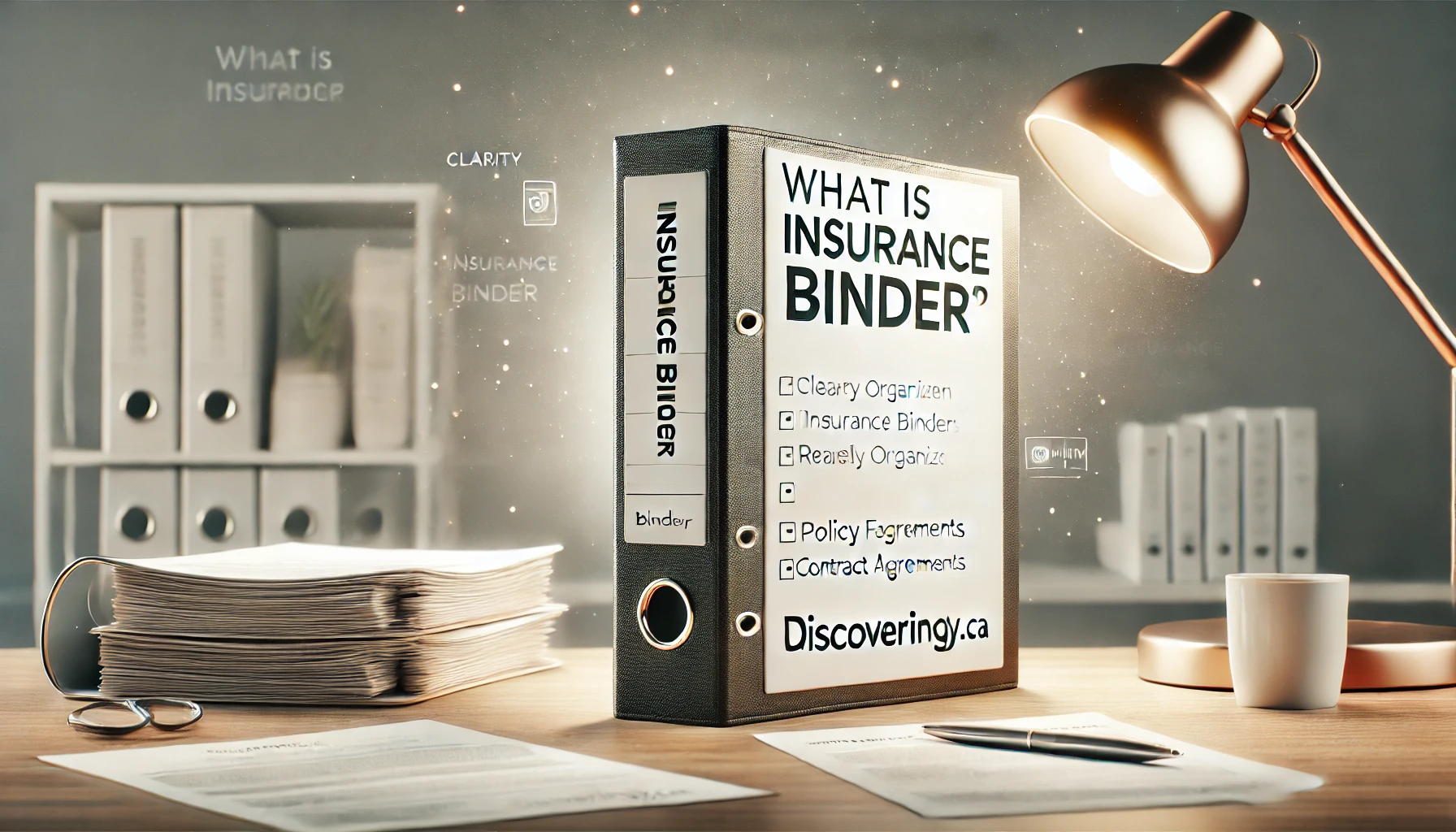What is an Insurance Binder? A Comprehensive Guide to Temporary Coverage
Introduction
When it comes to insurance, waiting for a formal policy to be processed and issued can take time. However, there are many situations where immediate proof of coverage is required, such as buying a home, purchasing a vehicle, or starting a business venture. This is where an insurance binder comes in. But what exactly is an insurance binder, how does it work, and why is it important? This comprehensive guide explores the concept of an insurance binder, its purpose, benefits, and key considerations.
What is an Insurance Binder?
An insurance binder is a temporary agreement that provides proof of insurance coverage until a formal policy is issued by the insurance company. Essentially, it is a short-term contract that confirms coverage is active and outlines the basic terms of the policy. Binders are used for various types of insurance, including auto, home, commercial, and liability insurance.
Binders are typically issued by insurers or authorized agents and remain in effect for a specified period, usually 30 to 90 days. During this time, the insurer finalizes the details and processes the formal policy, ensuring continuous coverage for the policyholder.
Key Features of an Insurance Binder
- Temporary Coverage
- An insurance binder provides temporary coverage until a formal policy is issued. This ensures that the policyholder is protected during the interim period.
- Legally Binding Document
- A binder serves as a legally binding document that outlines the terms of coverage agreed upon by the insurer and the policyholder.
- Proof of Coverage
- The binder acts as immediate proof of coverage, meeting legal and contractual requirements when a formal policy is not yet available.
- Issued by Authorized Insurers or Agents
- Only licensed insurance companies or authorized agents can issue a binder, ensuring that the coverage is legitimate and enforceable.
- Includes Key Policy Information
- The binder outlines important details such as the type of coverage, limits, effective dates, and any applicable terms or exclusions.
Purpose of an Insurance Binder
Insurance binders serve several key purposes, making them valuable in a variety of situations:
- Immediate Proof of Coverage
- When purchasing property, vehicles, or securing a business contract, you may be required to provide proof of insurance before completing the transaction. An insurance binder serves this purpose, offering assurance that coverage is active.
- Temporary Protection
- The binder provides temporary protection, ensuring there is no gap in coverage while the formal policy is being processed.
- Compliance with Legal and Contractual Requirements
- In many cases, legal or contractual obligations mandate proof of insurance coverage. An insurance binder fulfills this requirement, allowing transactions to move forward without delays.
- Simplifies Complex Transactions
- Real estate closings, vehicle purchases, and other significant transactions often require quick proof of insurance. A binder simplifies these processes by providing immediate coverage.
When is an Insurance Binder Used?
Insurance binders are used in a variety of scenarios where immediate coverage is necessary, including:
- Home Purchases
- Lenders typically require proof of homeowners insurance before approving a mortgage. An insurance binder ensures coverage is in place at the time of closing.
- Auto Insurance
- For new or used car purchases, an insurance binder provides proof of coverage, allowing buyers to register their vehicles and comply with legal requirements.
- Business Insurance
- Business owners may need a binder to demonstrate coverage for commercial properties, liability insurance, or other business-related risks.
- Real Estate Transactions
- Real estate deals often require proof of property insurance before finalizing a purchase. An insurance binder provides the necessary assurance that coverage is active.
- Construction or Contractor Projects
- Contractors may use an insurance binder to prove coverage for liability or builder’s risk insurance before beginning a project.
Key Components of an Insurance Binder
An insurance binder includes several essential components that outline the terms of the coverage being provided:
- Insured’s Information
- The name(s) and contact details of the policyholder(s) covered by the binder.
- Insurer’s Information
- The name, contact details, and license number of the insurance company issuing the binder.
- Type of Coverage
- A description of the type of coverage provided (e.g., homeowners, auto, commercial liability).
- Coverage Limits
- The maximum amount the insurer will pay for a covered loss, as specified in the binder.
- Effective Dates
- The start date and expiration date of the binder coverage.
- Premium Information (if applicable)
- The premium amount or payment terms, though this is more commonly detailed in the final policy.
- Terms and Conditions
- Any conditions, exclusions, or limitations that apply to the coverage provided by the binder.
- Binder Number
- A unique identifier for the binder, used for tracking and reference.
How to Obtain an Insurance Binder
Obtaining an insurance binder involves a simple process, typically managed through an insurance company or licensed agent. Here’s how it works:
- Contact an Insurance Provider
- Reach out to an insurance company or licensed agent to discuss your coverage needs.
- Provide Required Information
- Be prepared to provide personal details, information about the property or asset you wish to insure, and any relevant documentation.
- Review Binder Terms
- Carefully review the terms outlined in the binder, including coverage limits, deductibles, and any applicable conditions or exclusions.
- Sign the Binder (if required)
- In some cases, you may need to sign the binder document to acknowledge your acceptance of the terms.
- Receive the Binder Document
- Once issued, the binder serves as proof of coverage until the formal policy is finalized.
Insurance Binder vs. Insurance Policy
Understanding the differences between an insurance binder and a formal insurance policy is essential:
- Duration
- Binder: Provides temporary coverage for a specified period (typically 30 to 90 days).
- Policy: A permanent contract with a defined term (e.g., six months, one year).
- Level of Detail
- Binder: Offers a summary of key coverage details, such as limits and effective dates.
- Policy: Contains comprehensive terms, conditions, exclusions, and endorsements.
- Purpose
- Binder: Serves as immediate proof of coverage while the formal policy is processed.
- Policy: Represents the final, legally binding agreement outlining all coverage terms.
Benefits of an Insurance Binder
- Immediate Coverage
- An insurance binder provides immediate proof of coverage, ensuring protection during critical periods such as property closings or vehicle purchases.
- Compliance with Legal and Contractual Obligations
- Many transactions require proof of insurance to proceed. A binder fulfills this requirement quickly and effectively.
- Temporary Protection
- The binder bridges the gap between application and the issuance of the formal policy, reducing the risk of gaps in coverage.
- Simple and Quick Process
- Obtaining a binder is often faster and more straightforward than waiting for a full policy, providing peace of mind when coverage is needed urgently.
Potential Risks and Considerations
While an insurance binder offers valuable protection, there are potential risks to consider:
- Expiration of Coverage
- Binders are temporary and have a set expiration date. Ensure that the formal policy is issued before the binder expires to maintain continuous coverage.
- Differences in Terms
- The terms of the binder may differ from the final policy. Carefully review the formal policy to ensure it aligns with your expectations.
- Limited Details
- Binders may not include all the details and exclusions found in a full policy. Clarify any questions with your insurance agent or broker.
- Potential for Misunderstandings
- Miscommunications can arise if the terms of the binder are not clearly understood. Work closely with your insurer to avoid confusion.
Best Practices for Managing an Insurance Binder
- Follow Up with Your Insurer
- Confirm that your formal policy is issued before the binder expires to maintain continuous coverage.
- Review Coverage Terms
- Carefully review the binder and final policy to ensure that all coverage details align with your needs.
- Understand the Expiration Date
- Keep track of when the binder coverage ends and take steps to avoid lapses in coverage.
- Communicate with Your Agent
- Maintain open communication with your insurance agent to clarify any questions or concerns.
Conclusion
An insurance binder is a crucial tool for providing temporary insurance coverage and immediate proof of protection during key transactions. By understanding the purpose, key features, and limitations of an insurance binder, you can make informed decisions and ensure you’re protected when it matters most. Whether you’re purchasing a home, a vehicle, or securing business coverage, an insurance binder bridges the gap until your formal policy is in place.
For more insights into insurance, financial planning, and risk management, explore our comprehensive guides at Discoveringly.ca. Empower yourself with the knowledge to protect what matters most!






